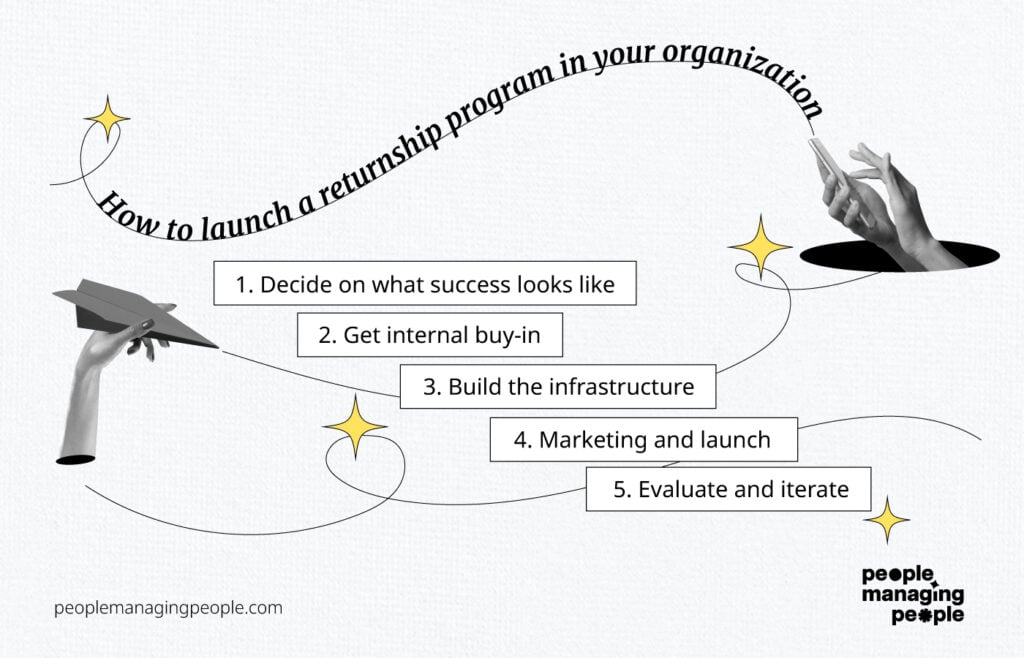Returnships are growing in popularity and for good reason. Top talent is hard to come by and a lot of workers are reevaluating what they want from their careers.
In this article, we’ll explore what a returnship program is and what the benefits are. Then we’ll dive into how to launch one in your organization using my former employer’s program as a case study.
- What is a returnship program?
- What are the benefits of returnships?
- How to launch a returnship program in your organization
What is a returnship program exactly?
A returnship program is a type of paid internship designed specifically for individuals who have taken a lengthy career break and are now looking to return to the workforce in a professional capacity.
It can also be utilized by workers who are underemployed, not using their skillset or education, or are looking to break into their new role or industry.
A returner could be a parent or caregiver who took off an extended period mid-career, or someone who took a job not utilizing their skills and is now finding it difficult to get back on their career path.
What are the benefits of returnship programs?
From an employer’s perspective, returnship programs help to widen the talent pool and promote diversity and inclusion by providing opportunities for often overlooked individuals from different backgrounds.
Throughout the program, the organization helps people develop new skills and potentially awards them a permanent position upon completion. It’s almost like a working interview!
From an employee’s perspective, a returnship program provides an opportunity for individuals to refresh their skills and gain knowledge in the field they wish to pursue. This can help them become more competitive in the job market after a break in employment or a period of underemployment.
Lastly, launching a returnship program sends the message that the company values its employees’ personal lives and provides a way back if they need to take a career break.
How to launch a returnship program in your organization

As mentioned, a previous employer of mine had a returnship program that I administered. The program was called the Graduate Professional Development Program and, while it wasn’t officially called a returnship program, that’s what it was.
The program was designed for individuals who were looking to get back into the workforce in a professional capacity after a lengthy time off from employment, those who were underemployed, as well as individuals who were recent college graduates.
Based on my experience, here’s my step-by-step guide and best practices for launching a successful returnship program.
1. Decide on what success looks like
Step one is to get clear about the purpose of your returnship program and what success will look like.
For example, the program I administered was designed to upskill returning professionals and recent graduates so they would be successful in a role at the company after the returnship ended.
The company was in the insurance industry and the returnship program mainly focused on hard-to-fill insurance roles, though we did offer a few IT and marketing roles as well.
You will want to define the goal of your returnship program first and build the program to achieve that goal. Determine how you will measure success and what metrics you will use to track it. Some key performance indicators could be program completion rate and retention after completion.
You’ll also want to determine the program duration, whether participants will have one role or rotate departments, and the budget.
Consider whether you want all participants to earn the same salary or set pay depending on the person’s work experience level and skills.
The program I administered was built for a small class of returners, about 12. They all earned the same salary for the duration of the program. Once they moved into their permanent role, their salary was commensurate with their role, skill, and experience.
Amazon’s returnship program is 12 weeks, while Goldman Sachs has a 6-month program, and my company’s was a full year. There is no standard for duration and differences in length can be attributed to industry and program structure.
2. Get internal buy-in
As with any large-scale project, you want to engage important stakeholders as early as possible.
Align the goals of the program with the company goals and sell the program as the investment in the company it is. A returnship program can be easily tied to your organization’s DEI goals, for example.
In order to have a successful program, you’ll need hiring managers willing to participate, so get several key hiring managers on board early to champion your cause. Talk with hiring managers early and often to gauge interest in participating in the program, and maybe enlist the help of senior leaders in the company to help you connect with these managers.
In addition to having enthusiastic hiring managers, you’ll also need senior team members to serve as mentors. Hiring managers can help identify top performers who would be a good fit, and you may already have a formal mentorship program that you can utilize as well.
3. Build the infrastructure
Returnship programs can vary widely in terms of length and class size, but successful programs have a few core components in common.
Structured onboarding and training
Returnship programs need to provide participants with a structured onboarding process that includes training and development opportunities tailored to their needs.
This can help them get up to speed on industry trends and best practices, as well as the company's culture and practices.
Training can be tailored to address both hard and soft skill needs of the participants, and shouldn’t be a one-size-fits-all approach.
Each participant’s training needs for successful re-entry can be assessed early in the program and their training can be assigned based on their unique needs.
My company had all participants start on the same day with the first week in the office. Accenture offers a 16-week returnship program, where all returners start in February.
This shared orientation allows for a deep dive into the company, its history, and its culture. It also provides participants the opportunity to get to know one another and form a cohort.
Meaningful work
Returnship participants should be given meaningful work that aligns with their skills and interests and provides them with opportunities to contribute to the organization's goals. This helps them to build confidence and makes them feel valued.
This is where programs will vary the most in terms of the actual work being performed during the program. However, the work should help build knowledge and skills the participants will use in their careers and chosen industry.
My previous company’s program was tailored to hard-to-fill insurance roles, and each participant spent the majority of their time performing on-the-job training for the permanent role they hope to fill at the end of the program.
For example, participants training to be an underwriter would shadow other underwriters part-time while they build the skills required to handle their own workload by the end of the program.
Mentorship and coaching
The best returnship programs include one-on-one mentorship and coaching opportunities to help participants navigate the workplace, build relationships, and develop their skills. This also helps them to set goals and track their progress throughout the program.
This coaching can come from managers and mentors, and feedback can be gathered from peers. Having relevant and timely feedback is important to participants as it helps equip them with the knowledge of how they can improve.
Amazon’s returnship program offers each participant a mentor to help guide them through the experience and support their growth. My company paired participants with both a manager and a mentor. For example, those participants training to be underwriters would have a top-performing underwriter as a mentor.
Networking opportunities
A successful returnship program will provide participants with opportunities to network with other professionals in the organization and industry. This can help them build relationships and potentially lead to future job opportunities.
The program I administered offered participants various opportunities to network with industry professionals through company-sponsored events. Participants were also offered the opportunity to attend industry events, both in person and virtual.
Additionally, employee resource groups are also a great way to build a network and connect to the organization so encourage returnees to join and get involved.
Flexibility
While returnship programs can’t typically offer part-time hours, they can offer flexibility in terms of scheduling and work arrangements to accommodate the needs of participants who may be transitioning back into the workforce while juggling other responsibilities.
Flexibility can be built into the program by offering portions of the training to be self-guided and self-paced.
Providing participants with the options for flexibility up front is key so they can make informed decisions about their participation in the program.
A clear path to full-time employment
Returnship programs should provide a clear path to full-time employment for participants who meet performance expectations. This incentivizes participants to perform their best and makes the program more attractive to potential candidates.
My former employer’s program offered a preselected, full-time role to returners who successfully completed the program. Returners must have a clear understanding of expectations for the program and know what success looks like.
4. Marketing and launch
Now that you have the program logistics figured out, you will need to market and launch the program.
I’d advise creating a landing page on your company career site dedicated to the returnship program that explains all about the program, the benefits, and how to apply (this is Amazon’s).
Once you have an established program, you can feature testimonials from successful returners, as Hubspot does:

Also, post your returnship openings on job boards and LinkedIn and encourage employees to share the program with their networks. Tap those early champions to promote the program on their professional profiles.
5. Evaluate and iterate
Last, but certainly not least, is measuring the results of your returnship program.
This loops back into the first step when you decided what success will look like for the company and for the participants and created key measurements that can be presented back to the stakeholders. Some key measurements are hire rate and tenure after program completion.
For example, my company found that a majority of male participants were leaving the company within 2 years of completing the program. A pivot was made to market the program more heavily to women who were looking to get back into the workforce after a lengthy career break.
Ready to Launch a Returnship Program in Your Org?
Overall, returnship programs can be beneficial for both individuals looking to return to work and companies looking to diversify their workforce and tap into a new pool of talent.
I remember one participant who was re-entering the workforce after taking a years-long career break to care for her young children.
She successfully completed the company’s returnship program, moved into an underwriter role, and then worked her way up to a director level where she was a vocal champion of the program!
By including the key components discussed above, a returnship program can provide a supportive and effective environment for individuals looking to return to the workforce, and provide your org with a pipeline of top talent.
Not quite ready to launch and want to read more:
Women Back to Work offer services to both returners and employers and has a wealth of knowledge on its website.
You can also seek advice in the People Managing People Community, a supportive community of HR and business leaders passionate about building organizations of the future.


